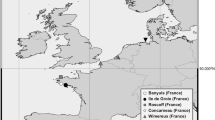Abstract
The common and geographically widespread freshwater worm Stylaria lacustris (Linnaeus, 1767) (Oligochaeta: Naididae) typically reproduces asexually through transverse paratomic fission during the spring, summer, and autumn. With the onset of shorter days and colder conditions, S. lacustris becomes a sexually mature simultaneous hermaphrodite and produces resting eggs that are capable of overwintering. However, like many naidid species, S. lacustris shows widespread variation in reproductive mode with some populations never attaining sexual maturity and others apparently exhibiting both sexual and obligately asexual genotypes. How then do obligately asexual genotypes and populations survive the harsh winter conditions? Extensive winter sampling of two, largely obligately, asexual populations of S. lacustris in Oxfordshire, UK, demonstrate that adult individuals can survive over the winter, but at densities way below that normally detected by standard sampling procedures. Laboratory experiments confirm that asexual individuals can survive cold water conditions but not freezing (unlike sexually produced cocoons). The proposed advantage of this seemingly risky reproductive strategy is that naidids like Stylaria, with their remarkably fast asexual reproductive rate, can respond instantly to favourable change in conditions.
Similar content being viewed by others
References
L. C. Armendariz (2000) ArticleTitlePopulation dynamics of Stylaria lacustris (Linnaeus, 1767) (Oligochaeta, Naididae) in Los Talas, Argentina Hydrobiologia 438 IssueID1–3 217–226
G. Bell (1982) The Masterpiece of Nature: The Evolution and Genetics of Sexuality University of California Press Berkely
O. V. Chekanovskaya (1981) Aquatic Oligochaeta of the USSR Amerind New Dehli
B. Christensen (1984) Asexual propagation and reproductive strategies in aquatic Oligochaeta G. Bonomi C. Erseus (Eds) Aquatic Oligochaeta Junk Dordrecht
E. Dumnicka (1996) ArticleTitleUpstream–downstream movement of macrofauna (with special reference to oligochaetes) in the River Raba below a reservoir Hydrobiologia 334 IssueID1–3 193–198
W. D. Hamilton R. Axelrod R. Tanese (1990) ArticleTitleSexual reproduction as an adaptation to resist parasites (A Review) Proceedings of the National Academy of Science 87 3566–3573 Occurrence Handle1:STN:280:By%2BB3sbgsFE%3D
Hughes, B. D., 1975. A study of a polluted river. Unpublished Ph.D. Thesis, University of Wales.
R. N. Hughes (1989) A Functional Biology of Clonal Animals Chapman and Hall London
L. D. Hurst W. D. Hamilton R. J. Ladle (1992) ArticleTitleCovert sex Trends in Ecology and Evolution 7 144–145
J. C. Koella (1988) ArticleTitleThe tangled bank hypothesis Journal of Evolutionary Biology 2 95–116
M. Ladle (1971) ArticleTitleStudies on the biology of oligochaetes from the phraetic waters of an exposed gravel bed International Journal of Speleology 3 311–316
R. J. Ladle (1992) ArticleTitleParasites and sex: catching the red Queen Trends in Ecology and Evolution 7 IssueID12 405–408 Occurrence Handle10.1016/0169-5347(92)90021-3
Ladle, R. J., 1994. The evolution of reproductive strategies in freshwater ecosystems: effects of population sub-division on the evolution and maintenance of sexual reproduction. Unpublished D.Phil Thesis, University of Oxford.
M. A. Learner G. Lochhead B. D. Hughes (1978) ArticleTitleA review of the biology of British Naididae (Oligochaeta) with emphasis on the lotic environment Freshwater Biology 8 357–375
G. Lochhead M. A. Learner (1984) ArticleTitleThe cocoon and hatchling of Nais variabilis (Naididae: Oligochaeta) Freshwater Biology 14 189–193
M. S. Loden (1981) ArticleTitleReproductive ecology of the Naididae (Oligochaeta) Hydrobiologia 83 115–123
A. Lomnicki (2001) ArticleTitleCarrying capacity, competition and maintenance of sexuality Evolutionary Ecology Research 3 IssueID5 603–610
C. F. Mason (1977) ArticleTitlePopulations and production of benthic animals in two contrasting shallow water lakes in Norfolk Journal of Animal Ecology 46 147–172
H. R. Mehra (1920) ArticleTitleOn the sexual phase of certain Indian Naididae Proceedings of the Zoological Society London 31 457–465
B. Schierwater C. Hauenschild (1990a) ArticleTitleA photoperiod determined life-cycle in an oligochaete worm Biological Bulletin 178 11–117
B. Schierwater C. Hauenschild (1990b) ArticleTitleThe position and consequences of a vegetative mode of reproduction in the life cycle of a hydromedusa and an oligochaete worm Advances in Invertebrate Reproduction 5 37–42
R. M. Sibly P. Calow (1982) ArticleTitleAsexual reproduction in protozoa and invertebrates Journal of Theoretical Biology 96 401–424 Occurrence Handle10.1016/0022-5193(82)90118-7
J. Stephenson (1930) The Oligochaeta Clarendon Press Oxford
E. Soumalainen (1950) ArticleTitleParthenogenesis in Animals Advances in Genetics 3 193–253
L. Watling (1975) ArticleTitleAnalysis of structural variations in a shallow esturine deposit feeding community Journal of Experimental Marine Biology and Ecology 19 275–313 Occurrence Handle10.1016/0022-0981(75)90063-5
Author information
Authors and Affiliations
Corresponding author
Rights and permissions
About this article
Cite this article
Ladle, R.J., Todd, P.A. Sex or Sanctuary: How do Asexual Worms Survive the Winter?. Hydrobiologia 559, 395–399 (2006). https://doi.org/10.1007/s10750-005-0700-9
Received:
Revised:
Accepted:
Issue Date:
DOI: https://doi.org/10.1007/s10750-005-0700-9




